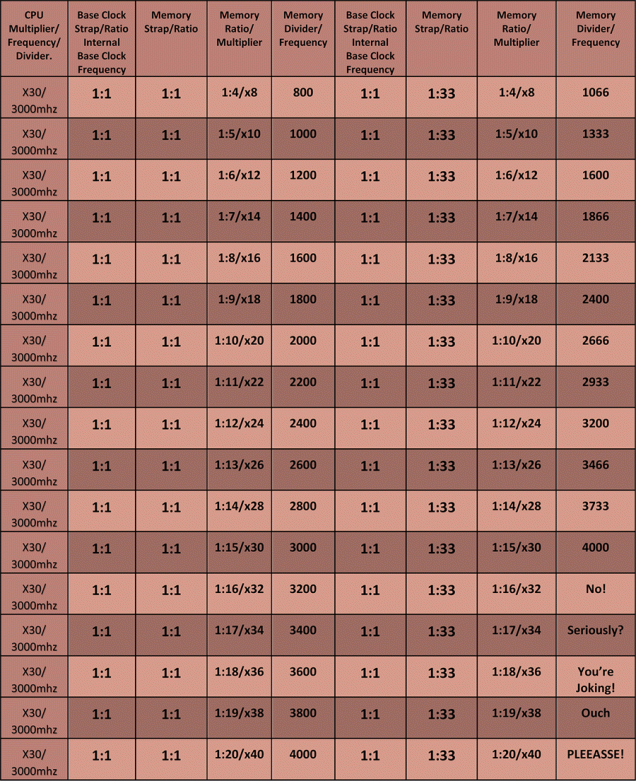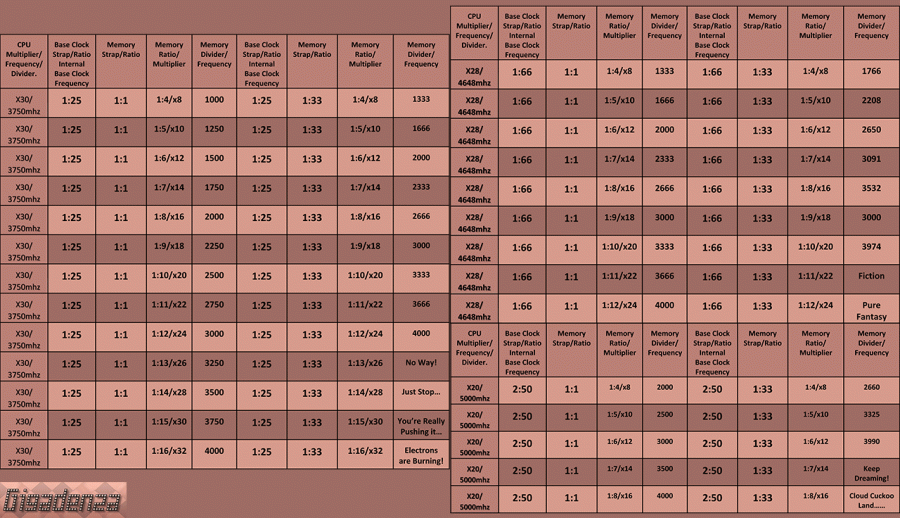The Case of the Befuddling Base Clock
Asus: Look at that! My talents permit no perimeters. A fourth tempting tinkering tier with a ratio of 2.5. A sensational super strap to pry a processor from its PCI prison. SHAME old master Intel can’t cough up one sturdy enough to drain my boards to their dregs. The straps were an interesting idea, but one deplorably developed and diabolically executed. A careless last minute whim. Brainstorm bilge that had I been privy to, I could have refined and afforded true purpose. An old dog should know where to sniff out new tricks, even if he can’t be taught any.
Intel: “Ho Ho Ho. How I adore unveiling tantalizing and superficially productive methods for idle hands to conjure extra reserves of speed, when all I’m really doing is experimenting, using their precious hours to establish how I should formulate and nurture my next revolutionary design. Should they somehow succeed in transforming my inventive but purely speculative gestures of goodwill into legitimate enhancements following hours of tortuous tampering, its no sheen off my wafers. Quite the contrary. They conduct painstaking research on my behalf with not a penny pried from my fathomless pockets.
Where’s the sense in wasting my transcendental talent on cumbersome clerical tasks when I can craftily repackage them as gauntlets to hurl at my gravest rivals. Mr Asus, you are no doubt to motherboard evolution what Wagner, Puccini and Bizet were to operatic omnipotence. But your reckless lust for competition mitigates your aptitude to recognise provocative challenges and shun tawdry gamesmanship, meaning that you shall never command such respect as the supreme entity whose very existence is the source of your prosperity….and sanity. Without me, your compositions would be mindless, soulless and senseless carcasses.Lobotomised slabs of sedentary circuitry. What could me a more sorrowful and pathetic scene.
Disowned fans trembling in a bootless blackness and whaling in hopeless expectation of life. Graphics cards with no ruler to grant their eyes light and guide them to recreational paradise. Memory in a terminal coma, unable to nourish the platters of hard drives, themselves strewn with stagnant, directionless data, unfit to pump around cold, dead lanes.
Logic Intervention: Eh excuse me Mr Intel. I’m not for one instant challenging your highly proficient parable. I understand your likening of the CPU to the human brain, very clever. But you do realise a motherboard with no RAM or video card would exude a similar level of uselessness, even if it did have one of your processors installed. Also, don’t forget that Asus’s BIOSES can be flashed via USB with no CPU or memory in residence. You just need flash drive containing a copy of the BIOS . Please don’t take offence, I don wish to defile your art or declare it any less important than you’re suggesting, but I know you’d want your facts to be firm as your fabrications, so to speak.
Intel: You impudent streak of inconsequential insignificance. Go and satisfy yourself by watching a thousand films and noting ten thousand continuity errors, mostly involving vanishing jewellery, crew members visible for one thousandth of a second, misplaced doorknobs, and anachronisms nobody cares about.
Oh! look, Jaws had 37 teeth in the last shot, now there’s just 35. Oh! look, Jack Sparrow’s cutlass has magically changed hands and shrunk by exactly nought point eight millimetres. Oh! Look. That wallpaper in the background is called Primo Pink Powdered-petal Poppy Plush and wasn’t available until 1965, yet I could have sworn this film is set in 1963, aren’t I the cleverest.
Logic Intervention: My apologies, I’d be damned to dispute your sagacity. Though interestingly, I did see an original Apple Macintosh the other day, in a movie said to take place in the late 1970s, a glaring error I’m sure you agree, since it was 1984 when they were rolled out.
Amazing, seems like so long ago. They used Motorola chips didn’t they? 68000s? Must have been tough times. Every force with different fortes and none powerful enough to prevail.
Intel: No tougher than the present.
Logic Intervention: I suppose not. But its incredible just how much history hinges on singular decisions. IBM for instance, your eldest and most influential client. How very fortuitous that it was your trusty 8088 he insisted should pilot the first “proper” PC. If he’d sided with Motorola, they’d have secured one murderous monopoly and then , who else would there have been to assure your affluence and motivation.
Intel: All tedious hearsay. There was not a bit of luck involved. It was a superior invention and no alternative merited a casual glance. In any case, do you really believe I’d have perished without his custom. What of his prospects if not for me? I’m not merely a genius, I’m a prolific genius. Others would have emerged and come begging for brains to afford their creations patterns of thought. Even the fickle fruity one saw came scampering to Daddy in the end.
Logic Intervention: I remember, Summer 2007, the first Intel powered Mac Pro.
Intel: 2006.
Logic Intervention: Quite right, hope they never make a movie of it.
When it comes to a processor’s propensities, no laws are without exception. Some of the most spellbinding spectral records have been shattered with minimal intervention, assuming an appropriately Arctic environment. There’s no indisputable reason why a drastically increased CPU multiplier should translate to improved or depleted stability when combined with an inflexible base clock, especially when accounting for the growing plethora of innovative tweaking techniques as well as others that have been practised since the onset of micro-malleability.
Moreover, BIOS anomalies such as reported voltages that don’t correspond to those physically supplied and errata related to initial batches of CPUs that were addressed in subsequent “steppings”, also contrive to render a definitive recipe for ultimate performance as unlikely as a palatable concrete casserole.
However, the acknowledged advantage of these extra regulation zones was not the to CPUs avail, but rather the RAM’s.
In an ideal synthetic universe, when XMP profiles were compiled, vendors would have either been entitled to or equipped themselves with a means of stringently auditioning each stick they purportedly hand picked in every single motherboard capable of initiating its basic abilities. While I’m no advocate of companies that make rash promises predicated on the merest hint of assumption I must nonetheless concede that, in our flawed organic cosmos, such a procedure would be as viable as a vicarage tea party on Venus.
Motherboards were too plentiful and too frequently revised, and their BIOSES developed at rates so astronomical that to conduct tests accommodating even an individual manufacturer’s full complement of assets would have been unrealistic. As for Asus, where to begin?! Thus, the finalized configurations endorsed by Corsair, Patriot, G.Skill and others amounted to diligent and well informed guesswork based on an incisive short list of test set-ups. Commendable, but not conducive to calculating your precious custom rig’s edge of reason.
Certain kits, including the ostentatiously orange quartet in question, were cosmetically crafted and binned with just one board in mind, namely, Gigabyte’s SOC Champion. But why should this obstruct owners of alternatives every bit as exorbitant and robust from reaping the same rewards?
There was no explicit assertion by Corsair or its foremost nemeses that the merits of their products were conditional on the ownership of qualified platforms and moreover would yield instability or sub-par throughput under any other circumstances. The problem was, when engaging the XMP signature, DIMM voltage, timings, frequency and even the system’s host clock, might all shift to settings that violently clashed with your particular motherboard’s inclinations. Suffice to say that in such cases, the capacious and purportedly assured extremities of deluxe and delicious DDR4 could only be exploited via a cornucopia of manual overrides and the choice of a severe strapping.
I’d like to sign off with a whimsical parallel. multiple straps for the CPU, base clock, memory and system clock could be likened to a quadruple crank-set for a cyclist tackling Mount Ventoux.
The cyclist represents the system or host clock and is just as hypersensitive. He has to pedal at roughly 100 rpm to keep from falling off the bike. The front crank set is the CPU’s internal host or base clock, with each of the four cogs posing as a strap or ratio. The teeth on the cogs number 100, 125 166 and 250 from little to large and, unlike conventional crank sets, can deploy or retract up to ten teeth while the bike is in motion and to the cyclist’s serene indifference. The memory meanwhile, is the rear wheel and the cassette, the RAM divider, with its cognizant brood symbolizing ratios, or multipliers.
The rotational velocity of both wheels must somehow be suitable counterpart to the memory’s microscopic oscillations, though quite how its speed corresponds to the pedal rate or how I prevent this analogy from prematurely careering off a cliff, are questions I didn’t anticipate. Actually, I did, but the answers were prohibitively expensive and only came with a six month return to base warranty.
Just before departing, I intend to lose a small amount of temper over the exasperating matter of definitions. Having visited a swathe of websites to harvest some of the crucial facts that made this extended summary a nightmare reality. I was utterly stupefied by how much confusion was perpetuated by provocative terminology and needlessly hindered by the ponderous task of mixing and matching a million monikers. It was truly shocking and must have added at least a century to composition time. In hindsight, nothing would lift my spirits more than to know that the wisdom conveyed by those jocular Gifs transcended all you could glean jargon that surrounds them. That’s it, you can go now.






